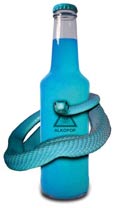 Thinking Drinking II wrap up
Thinking Drinking II wrap up
Three hundred delegates attended Thinking Drinking II: From Problems to Solutions which took place in Melbourne, Australia from the 26 - 28 February 2007.
Thinking Drinking II sought to identify and advance solutions rather than continue to describe the problems.
A major theme throughout the conference was the need for public health advocates to establish a limited set of demands, argue for them consistently and support their demands with a rational case based on sound evidence. Advocates need to show strong community support for the policies they espouse, because politicians respond only to causes supported by voters.
. . . . . Read more about the conference
Presentations from Thinking Drinking II, where available, are listed in alphabetical order by surname.
WHAT SHALL WE DO WITH A DRUNKEN SAILOR (SOLDIER OR AIRMAN)? ACHIEVING CULTURAL CHANGE WITHOUT THE LASH (PPT) [PDF, 171 KB]
WHAT SHALL WE DO WITH A DRUNKEN SAILOR? (MEDIA FILE) [MP3, 1.5 MB]
Air Vice-Marshal Tony Austin, Head Defence Health Services, Australian Defence Force
MAKING SENSE OF INTOXICATION [PDF, 35 KB]
Robert Barby, Community Safety Consultant
GETTING POLICY OVER THE LINE: ENCOURAGING WHOLE-OF-LOCAL-GOVERNMENT ACTION ON ALCOHOL HARMS [PDF, 33 KB]
Mark Boyd, Senior Project Officer, Health Inequalities, VicHealth
IF YOU BUILD IT THEY WILL COME: DELIVERING A WORKPLACE AOD PROGRAM [PDF, 30 KB]
Donna Bull, Chief Executive Officer, Alcohol and Other Drugs Council of Australia
ALCOHOL TAXATION AND THE LOW STRENGTH ALCOHOLIC BEVERAGE MARKET: UPDATING THE CASE FOR REFORM [PDF, 36 KB]
Donna Bull, Chief Executive Officer, Alcohol and Other Drugs Council of Australia
IMPACT OF SCHOOL ETHOS AND RELATIONSHIPS IN SCHOOLS [PDF, 219 KB]
Helen Butler, Manager, Professional Learning, Adolescent Health and Social Environments Program, Centre for Adolescent Health
TAKING THE ALCOHOL INDUSTRY TO COURT. IS IT WORTH IT? [PDF, 94 KB]
Bruce Clark, Director, Leigh Clark Foundation
LEARNING FROM THE LONG TERM TOBACCO CAMPAIGN [PDF, 70 KB]
Professor Mike Daube, John Curtin Institute of Public Policy, Curtin University of Technology
POTENTIAL FOR LITIGATION AGAINST ALCOHOL MANUFACTURERS [PDF, 55 KB]
Peter Gordon, Senior Partner, Slater and Gordon
DIRECTIONS FOR LAW ENFORCEMENT [PDF, 86 KB]
Inspector John Green, Manager, Alcohol Crime Project, State Crime Command, NSW Police
PSEUDO UNDERAGE LIQUOR SALES [PDF, 443 KB]
Sarah Jaggard, Manager, Alcohol Projects, Injury Control Council of Western Australia
LIQUOR LICENSING ACTION AS A CULTURAL CHANGE STRATEGY [PDF, 1.58 MB]
Gary Kirby, Director, Prevention and Practice Development, Drug and Alcohol Office and Naomi Henrickson, Manager, Alcohol Program, Drug and Alcohol Office
ENOUGH IS ENOUGH: CHALLENGING AND CHANGING WESTERN AUSTRALIA'S DRINKING CULTURE [PDF, 1.45 MB]
Gary Kirby, Director, Prevention and Practice Development, Drug and Alcohol Office and Naomi Henrickson, Manager, Alcohol Program, Drug and Alcohol Office
CULTURE AND ALCOHOL: THE WHAT, WHERE, WHEN, HOW AND HOW MUCH (PPT) [PDF, 158 KB]
CULTURE AND ALCOHOL: THE WHAT, WHERE, WHEN, HOW AND HOW MUCH (WORD) [PDF, 101 KB]
Sandra Kirby, Deputy Chief Executive Officer, Alcohol Advisory Council of New Zealand
IT’S HOW WE’RE DRINKING: HOW’S IT GOING? [PDF, 76 KB]
Sandra Kirby, Deputy Chief Executive Officer, Alcohol Advisory Council of New Zealand
ALCOHOL USE AND HARM AMONG YOUNG PEOPLE: THE DATA ON LOCAL GOVERNMENT AREAS [PDF, 95 KB]
Dr Anne-Marie Laslett, Research Fellow, Epidemiology and Surveillance Program, Turning Point Alcohol and Drug Centre
MANAGING ALCOHOL USE IN MELBOURNE’S LATE NIGHT ENTERTAINMENT PRECINCTS [PDF, 1.22 MB]
Colleen Lazenby, Manager, Safety and Wellbeing, City of Melbourne
ALCOHOL OUTLET DENSITY AND HARM: REVIEWING THE EVIDENCE [PDF, 60 KB]
Michael Livingston, Research Fellow, AER Centre for Alcohol Policy Research, Turning Point Alcohol and Drug Centre
PRACTICE AND CHANGE: WHAT LICENSED VENUES CAN DO TO ADDRESS ALCOHOL-RELATED ISSUES [PDF, 51 KB]
Dr Jane Mallick, Director, Centre for Youth Drug Studies, Australian Drug Foundation and Kimberley Banfield, Research Officer, Centre for Youth Drug Studies, Australian Drug Foundation
PROMOTING ALCOHOL TO YOUNG PEOPLE IN AOTEAROA: MARKETING INTOXICATION? [PDF, 232 KB]
Dr Tim McCreanor, Senior Researcher, Whariki Research Group, Massey University
IMPACT OF FORMAL ALCOHOL EDUCATION [PDF, 46 KB]
Associate Professor Richard Midford, Project Leader, National Drug Research Institute
MIND MAPPING [PDF, 808 KB]
Minds at Work
SUPERMARKETS, LOSS LEADING AND THE RELATIVE PRICE OF ALCOHOL [PDF, 107 KB]
Wendy Moore, Manager, Policy, Alcohol Advisory Council of New Zealand
COST-EFFECTIVENESS OF DRY AREA INTERVENTION TO REDUCE ALCOHOL CONSUMPTION IN INDIGENOUS AUSTRALIAN COMMUNITIES [PDF, 124 KB]
Michael Otim, Research Fellow, Health and Social Development, Deakin University
TAXING BEVERAGES THAT DRIVE IRRESPONSIBLY? [PDF, 51 KB]
Dennis Petrie, PhD Student, School of Population Health, University of Queensland
THE POTENTIAL OF THE WORKPLACE FOR ACHIEVING CULTURAL CHANGE: A CASE STUDY OF THE AUSTRALIAN CONSTRUCTION INDUSTRY [PDF, 1.32 MB]
Dr Ken Pidd, Deputy Director, National Centre for Education and Training on Addiction
DEVELOPING ADVOCACY AT A LOCAL LEVEL: HOW SERVICES CAN BE ADVOCATES [PDF, 34 KB]
Larry Pierce, Executive Director, Network of Alcohol and Other Drugs Agencies and Vanessa Long, Manager, Network of Alcohol and Other Drugs Agencies
TRANSLATING GOOD SPORTS INTO A NATIONAL PROGRAM [PDF, 360 KB]
John Rogerson, Director, Good Sports, Australian Drug Foundation
WHO WANTS TO GET DRUNK? INTOXICATION AS A PLEASURE AND A PURPOSE [PDF, 151 KB]
Professor Robin Room, Director, AER Centre for Alcohol Policy Research, Turning Point Alcohol and Drug Centre
DOES AGE MATTER? HOW AND WHEN TO INTRODUCE CHILDREN TO ALCOHOL? [PDF, 28 KB]
Associate Professor John Toumbourou, Senior Lecturer, Centre for Adolescent Health
AUSTRALIA’S NATIONAL ALCOHOL STRATEGY: REFLECTIONS ON THE POLICY DEVELOPMENT PROCESS [PDF, 127 KB]
Brian Vandenberg, Senior Policy Analyst, Premier’s Drug Prevention Council, Department of Human Services
IMPROVING LIQUOR LICENSING PRACTISE [PDF, 333 KB]
Gino Vumbaca, Executive Officer, Australian National Council on Drugs
A MULTI-STAKEHOLDER STRATEGY FOR DEALING WITH LOCAL PROBLEMS [PDF, 35 KB]
Ros Winkler, Drugs and Safety Planner, City of Boroondara
_________________________________________________________________































